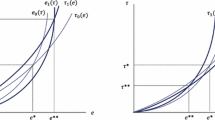Abstract
We consider the properties of a computable equilibrium model ofa competitive political economy in which the economic interestsof groups of voters and their effective influence on equilibriumpolicy outcomes can be explicitely distinguished and computed.The model incorporates an amended version of the GEMTAP taxmodel, calibrated to data for the United States for 1973 and1983. Emphasis is placed on how the aggregation of GEMTAPhouseholds into homogeneous groups affects the numericalrepresentation of interests and influence for representativemembers of each group.
Similar content being viewed by others
References
Aranson, P.H., Hinich, M.J. and Ordeshook, P.C. (1974). Election goals and strategies: Equivalent and nonequivalent candidate objectives. American Political Science Review 68: 135-152.
Ballard, C.L., Fullerton, D., Shoven, J.B. and Whalley, J. (1985). A general equilibrium model for tax policy evaluation. Chicago: University of Chicago Press.
Bentley, A. (1908). The process of government. Chicago: University of Chicago Press.
Coughlin, P.J. (1992). Probabilistic voting theory. Cambridge: University Press.
Coughlin, P.J. and Nitzan, S. (1981). Electoral outcomes with probabilistic voting and nash social welfare maxima. Journal of Public Economics 15: 113-122.
Coughlin, P.J., Mueller, D.C. and Murrell, P. (1990). Electoral politics, interest groups and the size of government. Economic Inquiry 28: 682-705.
Downs, A. (1957). An economic theory of democracy. New York: Harper and Row.
Enelow, J. and Hinich, M. (1989). A general probabilistic spacial theory of elections. Public Choice 61: 101-114.
Enelow, J. and Hinich, M.J. (1984). The spacial theory of voting. Cambridge: Cambridge University Press.
Goulder, L., Shoven, J.B. and Whalley, J. (1983). Domestic tax policy and the foreign sector: The importance of alternative foreign sector formulations to results from a general equilibrium tax analysis model. In M. Feldstein (Ed.), Behavioral simulation methods in tax policy analysis, 333-368. Chicago: University of Chicago Press.
Hettich, W. and Winer, S.L. (1999). Democratic choice and taxation: A theoretical and empirical investigation. New York: Cambridge University Press.
Hinich, M.J. (1977). Equilibrium in spatial voting: The median voter result is an artifact. Journal of Economic Theory 16: 208-216.
Hinich, M.J., Ledyard, J. and Ordeshook, P.C. (1973). A theory of electoral equilibrim: A spatial analysis based on the theory of games. Journal of Politics 35: 154-193.
Husted, T.A. and Kenny, L.W. (1997). The effect of the expansion of the franchise on the size of government. Journal of Political Economy 105: 54-82.
Kirchgässner, G. (2000). Probabilistic voting and equilibrium: An impossibility result. Public Choice 103: 35-48.
Ledyard, J.O. (1984). The pure theory of large two-candidate elections. Public Choice 44: 7-41.
Mayer, W. (1984). Endogenous tariff formation. American Economic Review 74: 970-985.
Owen, G. (1995). Game theory. Third edition. Academic Press (Ed.).
Piggot, J. and Whalley, J. (1987). Interpreting net fiscal incidence calculations. Review of Economics and Statistics 59: 685-694.
Poverty in the United States: 1990. Department of Commerce, Bureau of the Census. Current Population Report, Series P-60, no. 175.
Rutherford, T. and Winer, S.L. (1990). Endogenous policy in a computable general equilibrium framework. Working Paper 9007, Department of Economics, University of Western Ontario.
Rutherford, T. and Winer, S.L. (1990). Endogenous tax policy in a computable economic and political equilibrium: With application to the united states, 1973-1983. Carleton University School of Public Administration Working paper.
Scholz, J.K. (1987). Documentation for 1983 general equilibrium data. Mimeo, Stanford University.
Shoven, J.B. and Whalley, J. (1992). General equilibrium modelling. Cambridge: Cambridge University Press.
Usher, D. (1994). The significance of the probabilistic voting theorem. Canadian Journal of Economics 27: 433-445.
van Velthoven, B.C.J. (1989). The endogenization of Government behaviour in macroeconomic models. Springer-Verlag.
Van Winden, F.A.A.M. (1983). On the interaction between state and private sector: A study in political economics. Amsterdam: North-Holland.
Winer, S.L. and Rutherford, T. (1993). Coercive redistribution and the franchise: A preliminary investigation using computable general equilibrium modelling. In A. Breton, G. Galeotti, P. Salmon, and R. Wintrobe (Eds.), Preferences and democracy, 351-375. Norwell, Mass. and Dordrecht: Kluwer Academic Publishers.
Winer, S.L. and Hettich, W. (1991). Debt and tariffs: An empirical investigation of the evolution of revenue systems. Journal of Public Economics 45: 215-242.
Wittman, D. (1995). The myth of democratic failure: Why political institutions are efficient. Chicago: University of Chicago Press.
Yang, C.C. (1995). Endogenous tariff formation under representative democracy: A probabilistic voting model. American Economic Review 85: 956-963.
Author information
Authors and Affiliations
Rights and permissions
About this article
Cite this article
Hotte, L., Winer, S.L. Political Influence, Economic Interests and Endogenous Tax Structure in a Computable Equilibrium Framework: With Application to the United States, 1973 and 1983. Public Choice 109, 69–99 (2001). https://doi.org/10.1023/A:1012059101225
Issue Date:
DOI: https://doi.org/10.1023/A:1012059101225




